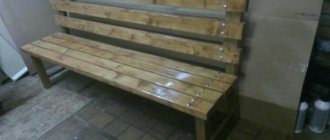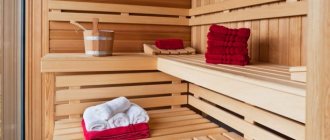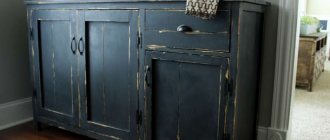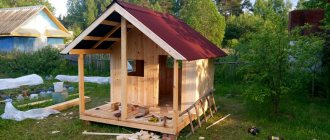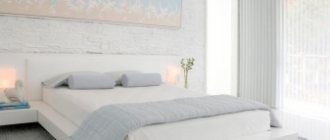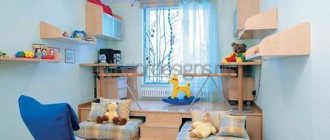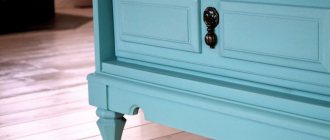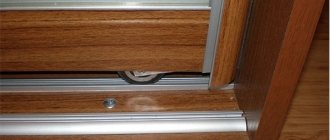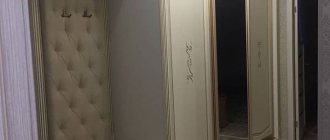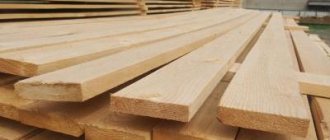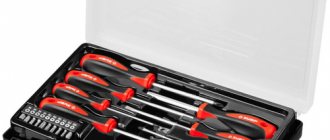Any garden plot has a specially equipped recreation area where owners and guests relax and spend time. It can be a large complex equipped with many landscaping elements. However, the area of a standard summer cottage does not allow sacrificing a significant part and forces one to limit oneself to a small rest area, the central and main element of which is a garden bench with a backrest. It is purchased ready-made and made to order. But most owners prefer to make benches with their own hands. Let's take a closer look at this issue.
Types of garden benches
Garden benches are distinguished according to certain characteristics. Among the first are the degree of product mobility:
- Portable . Can be installed anywhere and removed for storage in winter or in bad weather. The size and weight of the benches should be limited so that it is possible to move them to one point or another on the site. In addition, for storage you will need to allocate space in a barn or other auxiliary room.
Portable bench made of wood
- Stationary . They are installed in a predetermined location and cannot be moved. To protect against moisture or other external influences, periodic painting and cosmetic repairs are required. The material for such benches must be strong and durable.
There are few designs of garden benches, the main difference is in the configuration:
- Ordinary shop . The simplest design, which is a board on supports of the required height. Its disadvantage is the inability to completely relax ; you have to hold the torso in an upright position with muscle effort. Usually such designs are made in conjunction with a table.
- Bench with backrest . The most convenient and comfortable type, allowing a person to lean back and completely relax . Such benches are versatile and effective , giving you the opportunity to sit down for a few minutes or spend a lot of time enjoying fresh air and pleasant conversation.
The small number of designs is compensated by a huge number of design and stylistic options for the implementation of benches. Different materials are used, various technological methods are used to create products according to our own design.
Prices for ready-made garden benches
Country benches
Additional functionality – awnings over benches
If there are no shady areas on the site, then an additional canopy can be provided for protection from the sun. Let's look at several options for its implementation.
The canopy can be installed separately or made part of the structure, as in the presented photo. Here we see 4 racks made of timber, on which the top trim is made. The roof is formed by boards installed on edge - the classic form of a pergola. Lath trellises were added to the sides of the structure. All this will become a reliable basis for climbing plants, which after a while will provide beautiful and cool shade.
Pergola canopy
Installing a large canopy can be made from a simple bench into a swing. This functionality will be appreciated by both adults and children.
Bench with a wooden canopy in the form of a swing
Preparatory work
Before you begin the actual manufacture of the bench, you should perform some preliminary steps. The main one is the creation of a project, drawing or at least a sketch of the product. This will help you decide on the size, shape and design, and clarify all the necessary ratios (height and width of the seat and backrest, other parameters). In addition, you need to decide on technological aspects - select the type of bench, the material for its manufacture, prepare the necessary tools, etc. Let's look at these stages in more detail:
Material selection
Each owner of a private home has some skills in working with this or that material. Obviously, this will be the determining factor when creating the project. In addition, you should consider:
- Strength, durability, decorative possibilities.
- Availability and accessibility of material.
- Possibility of processing at home.
- The number and availability of tools needed to complete the work.
Guided by these considerations, the choice of material is made. Possible options:
- Metal . Provides high strength and durability . Various technology options are possible - welding, forging, assembly from ready-made profile elements. Requires appropriate equipment and corrosion protection . As a rule, metal benches are made stationary due to their heavy weight .
Example of a bench with a metal base
- Wood . Working with wooden parts is simpler and easier , and almost every home craftsman has basic skills. The material allows you to implement many design ideas and create any shape . In addition, wood is a good heat insulator . The main disadvantage is the tendency to warp , crack , and extremely low resistance to moisture . If a wooden bench is not protected from contact with water, it will quickly rot. It is possible to manufacture both stationary and portable structures.
Simple and lightweight wooden bench
- Plastic . It is not susceptible to moisture, does not rot , and does not change linear dimensions. Light weight allows for portable structures. Disadvantages include exposure to ultraviolet rays , as well as fragility when subjected to strong cooling . But the main disadvantage of plastic is the lack of high-tech processing . Prefabricated products are usually used, but there are some designs made from plastic bottles or sewer pipes.
Original bench made of plastic bottles
- Concrete . Used for the manufacture of supporting elements. The process is simple, the main condition is the presence of a mold for casting . The main advantage is simplicity , complete identity of all supports, and the ability to manufacture a large number of elements. In addition, the bases of concrete benches do not need to be immersed in the ground - they are massive and can simply be placed on the ground. The disadvantage is the large weight of concrete, the need to observe a certain holding time for crystallization.
Massive bench made of concrete base
- A natural stone . Stylish and attractive designs that are created from improvised or specially brought material. Most often, stone bases are made with a wooden or removable soft seat.
Stylish stationary stone bench
- Combined designs . A combination of different materials is often used. For example, metal supports are made onto which wooden or plastic backs and seats are attached. Combined benches allow you to combine the strength of metal , the warmth and ease of wood processing , and realize the various decorative possibilities of materials in the most successful way.
When choosing what to make a bench from, you need to remember about tools . Each design option requires the use of a specific set of devices, hand or power tools, designed to work with a particular material. In addition, measuring devices will be needed; for stationary types, it is necessary to make recesses for filling with cement mortar. The list of the required set of tools should be compiled as completely as possible at the design stage, so that during assembly of the bench you will not be distracted by searching for any small details.
Stationary or portable
Stationary benches are installed on supports immersed in the ground and filled with cement mortar for strength and stability. They can no longer be moved to another place, so you need to carefully and thoughtfully choose a place for them.
Metal stationary bench
Portable structures are mobile, can be placed in any convenient place and moved anywhere. This is a convenient option if the site layout has not yet been finalized.
Portable bench made of wood
Such benches are used in more gentle conditions, are not exposed to precipitation, and experience less mechanical stress. However, the constant movement of products requires effort, and storage requires a specially designated place, preferably indoors. Sometimes they make both stationary and portable benches at the same time. The former form the basic version of a relaxation corner, the latter are used when the need arises - a large number of guests, events, and other situations.
Shape and dimensions
The shape of the benches can be different:
- straight;
- corner;
- round;
- rectangular.
Round bench placed around a tree
Most of these products are installed permanently. Dimensions are selected based on the characteristics of the site, the expected number of people and the ergonomic requirements of the human body.
Note! The heavier and more massive the bench, the more difficult it is for lovers of easy money to drag it away from the site.
Curved garden bench
There are recommended ratios in the proportions of benches:
Table 1. Recommended bench parameters.
| Parameter | Recommended value |
| Seat height above ground level | 400-450 mm |
| Seat depth | 400-500 mm |
| Seat width | 1500 mm |
| Back height | 900-950 mm |
| Backrest angle | 115-120° to horizontal |
These values were developed by leading engineers and doctors and allow a person to take the most relaxed and comfortable posture.
Style
At first glance, it seems that a bench is not an important element of landscape design, but this is absolutely not the case. Experts confirm the fact that it is with the bench that garden design begins and ends with it. After all, why then such a rich variety of choice and why come up with original, bizarrely shaped benches if they are not so important and no one can enjoy them?
It is because of its importance that you need to pay a little attention to the placement of the piece of furniture. It is best to install it where the most beautiful and charming view opens up, and the bench itself should become an elegant accent that complements the perfect beauty of the country garden.
A comfortable bench in the garden of a summer cottage can become exactly the place where you can retire, break away from the hustle and bustle of everyday life, relax and take a slight breath, just enjoy the view of nature, feel unity with it. For complete enjoyment, you can read a good book, listen to quiet and calm music, or simply go on a mental journey. In addition to aesthetic use, functional use is also possible, because a bench is primarily a piece of furniture, as well as a “weapon” that can be used to zone the adjacent area.
A garden bench for a summer residence has a number of functional purposes, namely:
- Front door - installed at the porch of the house, near the entrance. It is a wooden bench with decorative ornaments, hand carvings, and can be used as a place for a photo shoot.
- Dining room - placed near the grill or barbecue, on the terrace or in any other place where the family prefers to dine outdoors.
- Garden - a small bench that is installed near flower beds, flower beds or in areas where you can sit down and relax a little while carrying out land work in the garden of a summer cottage. Often these are simple benches without any decorative decorations or unnecessary frills.
- Relaxation - often such benches are “hidden” somewhere in the quietest and most secluded corner of a summer cottage, away from anyone’s eyes. This place should be the quietest and most comfortable in order to enjoy the outdoors. The main requirement for such a bench is comfort; in addition, it can be of impressive size so that you can not only sit down, but also lie down.
Optimal dimensions for a bench that will be placed on the territory of a summer cottage:
- The height is about half a meter, the legs will reach the ground, but not rest too much, which means they can rest.
- The width of the seat is 50-55 cm, in addition, you can tilt it by 10-15 degrees to make it more comfortable to lean on and seem to “fall” inside.
- The height of the backrest is from 30 cm, but no more than half a meter; it is best to place it at an angle of 15-45 degrees, so that you can lean on it and lie down slightly on it.
- Armrests (if installed) should be located at a height of 15-29 cm from the seat.
The best material for making benches is wood, the most resistant to moisture and decay - larch, cherry, hazel and oak. The best option is teak, which contains natural resins in its species, which protect the piece of furniture from rot and various insects that destroy wood species.
The shape and appearance of the bench depends only on the whim and imagination of the person who will create it. By taking up the construction of a bench, you can personally bring all your ideas to life. If Country style was chosen, then the shape of the bench should be as simple as possible, and the color should be brown or natural. If you build a bench in the Provence style, you will have to make an antique bench, and then paint it white or blue (blue, purple, blue).
If the cottage has an oriental style and the bench should correspond to this, then it can be made of bamboo. In general, benches made from a similar type of wood should be installed near wooden dachas.
Choosing a bench style and design
Design development is a multivariate and complex stage of creating a project. Every person can draw simple models on paper; others will require considerable imagination and artistic ability. The Internet can be of great help, where there are a large number of photographs of finished products made from different materials and in one style or another.
As a rule, site owners create recreation areas in the same style with all other landscaping elements, forming a harmonious image of the site. There are no restrictions in this matter; the criteria are only your own taste, sense of proportion and preferences.
Stylishly designed bench
You can also find ready-made drawings of garden benches online, with dimensions and other useful information. The use of ready-made images gives a tangible impetus to imagination and saves time and effort for those who find it difficult to independently design an original and attractive product design.
Choosing a place to install the bench
Find out how to make a swimming pool at your dacha with your own hands, and also check out the options and step-by-step installation in a special article on our portal.
Step-by-step instructions for making a wooden bench
Let's consider the procedure for creating a wooden garden bench. The process of assembling a regular product, without complex decorative elements, will be described.
Tools and materials
You will need the following tools:
- Electric saw (circular).
- Jigsaw.
- Hand hacksaw.
- Electric drill.
- Manual or electric planer.
- Sander.
- Screwdriver with a set of bits, self-tapping screws.
- Hammer, pliers, screwdriver, pencil.
- Ruler, tape measure, square.
- Paint, solvent, brush or roller (optional electric sprayer).
Prices for popular models of electric planers
Electric planer
Set of tools
Attention! Only the necessary tools are indicated; the list can be expanded according to the requirements of your own project or technological need.
Materials:
- Edged boards 30-50 mm thick depending on the size of the bench.
- Bars with a cross section from 30:50 to 50:50 mm for assembling the planes of the back and seat.
The wood must be properly dried to the required moisture content.
Table 2. Weight of wood of different species depending on humidity.
| Wood species | Weight of 1 m3 of wood of different humidity | |||
| 15 % | 30 % | 50 % | 70 % | |
| Pine | 510 kg | 550 kg | 640 kg | 720 kg |
| Larch | 670 kg | 710 kg | 820 kg | 930 kg |
| Birch | 640 kg | 680 kg | 790 kg | 890 kg |
| Spruce | 450 kg | 490 kg | 560 kg | 640 kg |
Using the data in this table, you can roughly determine how prepared the material is for work. A moisture content of 70% is freshly cut wood, and 15% corresponds to the state of a chamber-drying solid wood that has been stored outside the chamber for some time. By weighing the appropriate number of boards, you can get an idea of the presence of moisture and the possibility of working with this material without drying.
Important! The planes of the seat and back can be made of boards, but the bars do not warp so much, dry out, and are less susceptible to cracking and being turned by a “propeller.”
Assembly order
Working drawing of a wooden bench
Step 1. Based on the drawing data, blanks are cut from the boards.
Cutting the blanks
Step 2. The surfaces of the parts are processed using a manual or electric plane.
We process the boards with a plane
Step 3. The oblique sections are cut off from the backrest supports and lower crossbars.
We are completing the preparation of the components for our bench
Step 4. The supporting elements are assembled. Self-tapping screws or nails are used, which simplifies but weakens the connection. When connecting parts, you should check the position of the parts using a square.
We start assembly from the bottom, supporting part
Step 5. The supporting parts are connected by the bottom crossbar.
Install a “spacer” between the support legs
Step 6. Planks are installed on top to form the plane of the seat.
Helpers will be very helpful!)
Step 7. The slats that form the back are installed.
Mounting the backrest
Step 8. The assembled bench is carefully processed with a sander, removing all sharp edges, irregularities, burrs or burrs of fibers left by the plane. It is recommended to remove the chamfers so that there is no danger of splintering your hands or other parts of the body.
We carry out final polishing with a grinder
Step 9. The sanded product is covered with several (at least 2) layers of paint. You must wait until the first layer has completely dried before applying the next one. Sometimes interlayer grinding is performed to increase the smoothness and accuracy of the surface. There are no special requirements for the number of layers; it is customary to be guided by the appearance of the product.
Painting our bench
Step 10. To create stationary wooden benches, you can use the same technological sequence, you just need to add the stages of digging recesses and pouring wooden or metal supports into the concrete bases.
Concreted support
The assembled bench is attached to them using threaded connections or regular nails. The stationary option increases the stability of the product, but complicates the periodic painting of the benches - they cannot be turned over to simplify the process.
Video - Simple DIY wooden bench
Step-by-step instructions for assembling a metal garden bench
The design of a stationary metal bench is not difficult. It consists of supports concreted into the ground, to which corners are welded for installing a wooden seat and backrest. Installation of such products is accessible even to an inexperienced craftsman and does not require separate consideration.
Simple metal bench
It is recommended that people who have not undergone professional training use a profile pipe to assemble a portable metal bench. It is equipped with flat surfaces that allow parts to be tightly and securely installed end-to-end or overlapping. For assembly, a welding machine with electrodes or bolts and nuts are used. In addition, you will need:
- Grinder with cutting disc for metal.
- File for cleaning pipe ends.
- Ruler, tape measure, square.
- Chalk, pencil.
- Electric drill with a set of drills.
- Bolts and nuts for attaching the seat slats (or for completely assembling the bench).
- Paint, brushes or spray.
- Personal protective equipment - welding suit, mask, goggles, gloves, etc.
Prices for angle grinders (grinders)
Angle grinders (grinders)
Drawing of a metal bench from a profile pipe
Second drawing of a metal bench from a profile pipe
Procedure:
- According to the working drawing, cut to the length of the workpiece .
- Clean sharp edges with a grinder or file .
- Weld the details of the side supports according to the drawing data . You should constantly adjust the position of the parts along the square and check the length of the diagonals.
- Connect the side supports with the bottom crossbar, grabbing it with point contractions and carefully align the position with the square.
- Grab the backrest parts and check their position again using a square.
- Boil all connections to obtain maximum strength.
- Use a hammer to beat off the scale , and use a grinder to clean areas with sloppy seams.
- Paint the bench frame with two coats of paint.
- Punch and drill holes for installing the back and seat strips.
- Install the seat and backrest . For convenience, they are varnished or painted in advance.
Prices for various types of wood varnishes for outdoor use
Wood varnish for exterior use
Between applying layers of paint, it is necessary to wait for the layer to dry completely, otherwise the coating will not be resistant to moisture, will wrinkle or bubble.
Wrought iron garden bench
Forged garden benches are made by craftsmen with appropriate training and conditions. Products made using this technique are particularly beautiful, stylish, and create a special look for the garden area. Without skills, it is pointless to take on the creation of such structures, but you can order the production of individual parts or elements and assemble them with your own hands on the site.
Video - Making and installing a bench from a metal profile
Sometimes they do it even simpler - they assemble a metal frame, which is decorated with decorative elements ordered from a specialized workshop. The result is a highly artistic product, not inferior in appearance to solid forged benches from famous masters. Such samples require appropriate care, protection from external influences and corrosion.
Forged bench with a seat made of a solid wooden panel
Materials
There is a large selection of materials that are used to make benches. The most common option is wood. And there is nothing surprising here. It is considered easy to process, affordable and lightweight.
It is not necessary to use identical, perfectly even bars. If you take natural material in its natural form, then the final result will certainly please both hosts and guests. Instead of an ordinary bench, you will get a real decoration for your garden plot.
Stone structures are also popular. They are durable and aesthetically pleasing. But there are also disadvantages. It is recommended to sit on them only in warm seasons.
Hallways 2022: TOP-200 photos of the best new products and modern design. Options for the ideal combination of color and style of furniture in the hallway- DIY stool: manufacturing methods and instructions for creating simple and stylish models (90 photo ideas)
- Do-it-yourself door finishing: 115 photos of the best options for entrance and interior doors
Forged products are the best choice for fans of luxury and elegance. However, this option is not suitable for those who are looking for how to make a bench with their own hands. Only an experienced blacksmith will make high-quality and beautiful metal structures.
Models that combine various materials look good. For example, a bench made of wood can be decorated with textiles (pillows, bedspread). This will make it feel homely and comfortable.
Useful tips
We know how else you can decorate your site! We recommend reading our material on the topic – Hedge (fast-growing perennial evergreen).
Experienced craftsmen use some techniques to speed up the assembly or finishing of finished products. Let's look at some of them:
- Assembling metal benches with bolts allows , if necessary, to disassemble the structure and reuse the resulting material. At the same time, the nuts must be reliably protected from rust so that they do not have to be cut off.
- To make finishing easier, it is recommended to paint the parts before assembly . This applies to wood backs and seats attached to a metal frame, or other components that do not require welding. At a minimum, a first coat of coating is applied, although a full finishing can be done.
- When manufacturing heavy parts (concrete castings, massive welded supports for long structures), it is recommended to carry out work as close as possible to the installation site so that you do not have to carry the finished product over a long distance.
How to do it - examples
The design of the bench and the bench are slightly different. A bench is just a place to relax without a back or armrests. The bench looks more presentable; if desired, garden furniture can be decorated with carvings or forged elements, and armrests can be added. Benches with unusual shapes look great.
To build a simple garden bench with a backrest in the simplest way, you can use boards and wooden boxes as support. It is better to pre-paint or varnish the latter to highlight the texture of the wood.
By the way, if you fill the boxes with soil and plant annual flowers, you will get an impromptu flowerbed made with your own hands. Choose unpretentious plants that do not require complex care. How to do:
- The boards used for sitting are processed (planed).
- If necessary, you can go over the surface with sandpaper to remove all irregularities.
A bench with a base of drawers can easily be turned into a comfortable bench. The structure must be installed against the wall, onto which several narrow slats or boards must be nailed as a backrest.
And now about the shortcomings. The tree requires constant care and does not tolerate moisture. Therefore, it is better to install the supports on a layer of waterproofing material or a base of paving slabs. If this is not possible, it is better to replace wooden boxes with cabinets made of concrete or stone.
Treated wood is suitable for seating. The boards can be painted or simply treated with special protective compounds. The boards are attached to the base using metal corners. As fasteners - dowels (for concrete), self-tapping screws - for wood.
Instead of supports, you can use decorative flowerpots with shrubs or dwarf trees. The main thing is that the pots should be as simple in shape as possible and made of durable material. To make an unusual bench, just cut holes in the boards in the shape of flowerpots, which will also serve as a base.
Also read: Flower beds and flower beds with your own hands at the dacha that bloom all summer
It is not necessary to attach the seat to the base. The design will still be stable.
